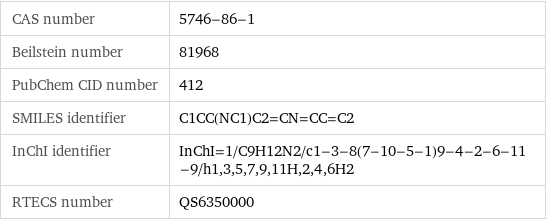Input interpretation

DL-nornicotine
Chemical names and formulas

formula | C_9H_12N_2 name | DL-nornicotine IUPAC name | 3-pyrrolidin-2-ylpyridine alternate names | nicotine, 1'-demethyl-, (+/-)- | (+-)-nornicotine | nornicotine | (R, S)-nornicotine mass fractions | C (carbon) 72.9% | H (hydrogen) 8.16% | N (nitrogen) 18.9%
Lewis structure

Draw the Lewis structure of DL-nornicotine. Start by drawing the overall structure of the molecule, ignoring potential double and triple bonds: Count the total valence electrons of the carbon (n_C, val = 4), hydrogen (n_H, val = 1), and nitrogen (n_N, val = 5) atoms: 9 n_C, val + 12 n_H, val + 2 n_N, val = 58 Calculate the number of electrons needed to completely fill the valence shells for carbon (n_C, full = 8), hydrogen (n_H, full = 2), and nitrogen (n_N, full = 8): 9 n_C, full + 12 n_H, full + 2 n_N, full = 112 Subtracting these two numbers shows that 112 - 58 = 54 bonding electrons are needed. Each bond has two electrons, so in addition to the 24 bonds already present in the diagram add 3 bonds. To minimize formal charge nitrogen wants 3 bonds and carbon wants 4 bonds. Identify the atoms that want additional bonds and the number of electrons remaining on each atom: Fill in the 3 bonds by pairing electrons between adjacent highlighted atoms. Note that the six atom ring is aromatic, so that the single and double bonds may be rearranged: Answer: | |
3D structure

3D structure
Basic properties

molar mass | 148.21 g/mol phase | liquid (at STP) boiling point | 91.5 °C (measured at 50 Pa) density | 1.074 g/cm^3
Units

Liquid properties (at STP)

density | 1.074 g/cm^3 refractive index | 1.54
Units

Chemical identifiers

CAS number | 5746-86-1 Beilstein number | 81968 PubChem CID number | 412 SMILES identifier | C1CC(NC1)C2=CN=CC=C2 InChI identifier | InChI=1/C9H12N2/c1-3-8(7-10-5-1)9-4-2-6-11-9/h1, 3, 5, 7, 9, 11H, 2, 4, 6H2 RTECS number | QS6350000
Safety properties

flash point | 101 °C

DOT numbers | 2810
Toxicity properties

RTECS classes | other